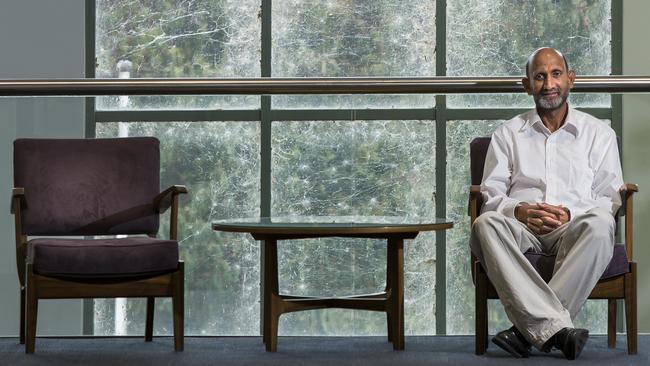Chennupati Jagadish is the new president of the Australian Academy of Science
Chennupati Jagadish could easily have spent his life in the Indian village where he grew up. Now he heads the Australian Academy of Science.

Few can personally testify to the value of education as much as Chennupati Jagadish, the new president of the Australian Academy of Science.
For over 30 years he has been a physicist at the Australian National University, where he makes some of the world’s tiniest lasers, which promise to revolutionise electronics and take computing power and internet communications to the next level.
But Professor Jagadish grew up in a small village in southern India.
“I studied in front of a kerosene lamp until I finished my year 7. I lived with my maths teacher in a neighbouring village to be able to finish my high school,” he says.
Today he credits two of his teachers with changing the course of his life. “Without their help, probably I’d be ploughing the fields in India today,” he says.
But, because he seized his opportunities, he went on to complete bachelors, masters and PhD degrees in India, and get a research job. Following that he went to a Canadian university for two years. “And then (in 1990) I came to Australia with my wife and two-month-old baby and a two-year contract at the ANU,” he says.
Now he has been in Australia for 32 years.
In the intervening period he has become one of Australia’s most distinguished scientists. He was awarded an AC – Australia’s highest civilian honour – in 2016. He has nearly 900 research papers to his credit, and he is a distinguished professor and head of the ANU’s semiconductor, opto-electronics and nanotechnology group.
In his new four-year role Professor Jagadish heads Australia’s learned Academy for Science, a body whose fellows are elected by their peers in recognition of the importance of their research.
It’s an exclusive group – no more then 24 new fellows can be admitted each year – and, as president, Professor Jagadish is chief advocate for Australia’s most distinguished scientists.
He is going to the new federal government with a clear list of priorities.
One is a comprehensive review of Australia’s science and research system to eliminate overlapping government responsibilities and wasted funding. The academy says that science research is administered through 202 separate government programs and 13 federal portfolios, resulting in fragmentation, duplication and gaps.
The review needs to cover the “full spectrum from basic science to applied science to commercialisation of technologies”, Professor Jagadish says. “Otherwise we do these piecemeal investments.”
Second, he says it is crucial for the government to have a long-term plan to fund scientific research. “There is so much evidence that funding for two or three years, and stopping it and restarting again for two or three years, is not really the most effective way of getting the outcomes which we would like to have as a nation,” he says.
He points to the fact that Australia’s research spending is in long term-decline, dropping from 2.25 per cent of GDP in 2009-10 to 1.79 per cent in 2019-20.
Nothing should focus our attention more on the need for a strong research sector backed by long-term funding than the experience of the pandemic, he says.
”If you look back, fundamental, basic science has been going on in mRNA technology for the last 30 years or so. That has allowed us to come up with these vaccines in such a short time,” he says.
With the current policy focus on the commercialisation of science he says it is crucial that basic research, which has no immediate commercial possibilities, is strongly supported.
“By not investing in basic science, I always tell people that we are building a building with no foundation. This building will last for some time. But if we get a big wind then this building is going to fall down,” he says.
Professor Jagadish also calls for the establishment of a parliamentary science office – akin to the current Parliamentary Budget Office – so that any MP who is assessing legislation “can go and ask what science is saying about this particular policy”.
Another priority for him is to get better financial support for up-and-coming scientists. If we want to attract the brightest students “we really need to support them properly so that they are not in the difficult position of having to choose between whether they have the money to pay rent or have a decent meal”.
While representing Australia’s scientists at the highest level, Professor Jagadish continues his research at ANU, and training the next generation of scientists in his field.
”We’re developing nanotechnology to be able to make some of the smallest lasers in the world. And I can put about 20 lasers in the width of your hair,” he says.
One use for the tiny lasers is in communication between computer chips via so-called optical interconnects, which eliminate data flow bottlenecks that occur with electricity in wires. ”They consume less energy and you can switch them on and off faster. That means you can send information much faster,” he says.




To join the conversation, please log in. Don't have an account? Register
Join the conversation, you are commenting as Logout